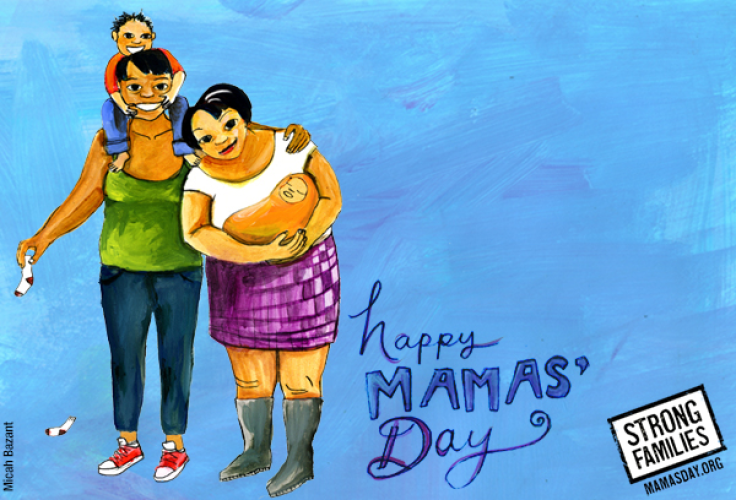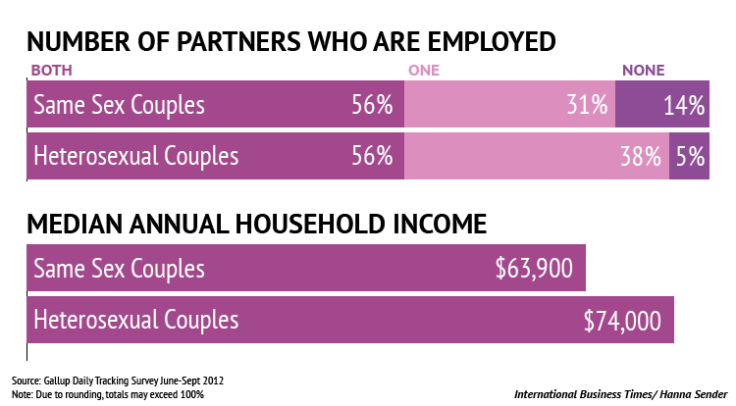Mother's Day: The Trials And Tribulations Of Being A Lesbian Stay-At-Home Mom

For nearly three years, Alex Kent has lived a life full of snacks, diapers and spit up. After her wife gave birth to their son, Kent decided to leave her job in the nonprofit world to become a stay-at-home mother where playdates have waiting lists, and everything from putting on a jacket to going to bed is considered a project.
“I didn’t actively decide I wanted to stay home. It was more a combination of different factors,” Kent, 34, said. Those factors included the exorbitant cost of full-time childcare in New York City and the fact that her wife, Lisa, who is a doctor, had recently accepted a fellowship in Baltimore.
“I was going to be leaving my job anyway,” Kent said. “I was professionally in a position where my responsibilities were about to increase in a way that would have been really exciting, if I didn’t have an infant at home.”
Kent and Lisa are among 16,000 lesbian couples with children in the United States that have a stay-at-home parent. That number is slim relative to the number of heterosexual couples with stay-at-home moms, which is estimated at 7 million.

Statistics paint a grim picture for lesbian stay-at-home moms: On average, they are comparatively less educated and closer to the poverty line, and the challenges they face are at once different and typically more pronounced than those of their straight counterparts.
“There are whole sets of things lesbian couples have to think about that heterosexual couples take for granted,” Lee Badgett, an economics professor and senior scholar at the Williams Institute, told International Business Times. Kent and Lisa (who asked that her last name not be used), are legally married, but those who do not live in states where gay marriage is legal “don’t have the same legal rights that people in different sex couples have,” Badgett noted. The rights denied them encompass health insurance coverage, tax benefits and child custody. And because both are women, they face twice the gender pay gap as heterosexual couples.
“That’s a double whammy,” Badgett said. “Two women earn less than a man and a woman when you look at couples' incomes.”
Robert-Jay Green, founder and senior research fellow at the Rockway Institute, a national center for LGBT research, education and public policy at Alliant International University in Alhambra, California, echoed that assessment.
“Because women on average are paid less than men for the same work, lesbian parents will be less able to take time off from work to be stay-at-home moms,” he said. “The traditional stay-at-home mother arrangement presumes a male breadwinner who is paid a whole loaf of bread, not a female breadwinner who is paid only 76.5 percent of a loaf for equal work."
For Kent, income wasn’t an issue. Lisa, who is in fellowship in pediatric hematology and oncology, is able to support their family as a single-wage earner. But planning to have children was a challenge, especially because same-sex marriage was not legal in New York state when Lisa bore their son.
“I’ve always said by nature we have to decide to have children and go through all these extreme efforts to have them so they’re going to be loved and cherished in ways that not all children are,” Kent said. She pointed to the fertility treatments, the legal paperwork including wills, and the second-parent adoption process her family had to undertake when they decided to have a child – a long process that their family has yet to complete.
“Technically, I’m not his legal parent,” Kent said. That brings the potential for complications for such things as signing school forms for him or authorizing her son’s medical treatment – which she can do, though she keeps a copy of the document in his diaper bag just in case.
Kerry-Lynn Turner LaFlamme, a stay-at-home lesbian mom to 6-year-old twins, can relate to the complications behind having a child before same-sex marriage was legalized in her home state of New Hampshire.
“We had to do some serious planning to have kids. We made sure we had all the paperwork in order,” LaFlamme, 43, said. She recalled the expense and minute details such as determining whether her wife’s company would cover her health insurance once she stopped working.
“It was definitely more expensive than a heterosexual couple that was just going to have kids. They could just have kids,” she said. “But we wanted it and this is what we needed to do.”
Badgett pointed to such hurdles as one of the main motivators behind the gay-marriage debate.
“As same-sex couples have fought for the right to get married, one of the reasons they give is because they have children,” she said. Marriage can serve both practical and emotional purposes in a family, she noted. “I think the main misconception people have is that gay people don’t want to have kids. We have lot of survey data that shows that’s not true.”
Beyond the psychological benefits equal marriage can bring, Green pointed to the economic stability same-sex marriage can afford.
"Marriage makes it less risky for a parent to sacrifice her career to take care of the couple's children, because a married stay-at-home parent has the assurance that spousal support and community property laws will provide some buffer if the couple later divorces,” he said. “If an unmarried stay-at-home lesbian mother and her partner separate, she might be left completely destitute financially.”
Regardless of sexual orientation, once motherhood hits, the hurdles come one after the other.
“It can be really isolating, especially moving to a place where you don’t know people,” Kent said. Her family moved from New York City to the Baltimore suburbs once her son was born, and while her wife worked 80-hour workweeks plus a long commute, she spent a lot of time alone before finding “mommy groups” in her community.
“It was a little like being in the middle-school playground, having to go out and make friends. I’m like, ‘I’m in my 30s, I’m done with this. I don’t want to go and make friends,’” she said. Kent came out when she was 13 years old and has remained open about her sexuality, but she soon realized that having a child took away any chance she had of keeping that part of her life private.
“I’ve always been extraordinarily out everywhere I go. But having kids takes away all your choices about whether you’re out,” she said. “You’re out on the playground and they start saying ‘mommy’ and ‘mama’ -- you have no control. I kind of like that, but for some people it’s difficult.”
LaFlamme has similar memories making “mommy” friends.
“As a gay woman, when you’re younger, you don’t feel like you have to come out to everybody,” LaFlamme said. “But when you have kids you have to come out almost every day, it feels like.”
For Kent, creating a network of stay-at-home mom friends outside the cosmopolitan world of New York City had its share of surprises.
“Being a stay-at-home-mom, I have so much in common with other stay-at-home moms that my social network is more diverse than it ever was before,” she said. “Like, I’m friends with Republicans -- genuinely friends – which was never the case in my college years or in New York.”
While she found other stay-at-home lesbian moms to connect with, conversation centered more on the children than who their parents were.
Among her state-at-home network, most of the women spend more time with each other than with their significant others, she said. “We all have the same complaints about our spouses, whether they’re male or female.”
LaFlamme agreed.
“We talk about how the kids are doing, their poop schedule,” she said, referring to common grievances among her stay-at-home mom friends. “It’s the same thing. You’re raising kids. It’s nice to have friends – no matter straight or gay – to talk to. To make sure you’re not going crazy.”
Many people see stay-at-home lesbian moms as a radical departure from the norm, but the reality, according to Stephanie Coontz, a professor of history and family studies at Evergreen State College in Olympia, Washington, is that the concept of heterosexual stay-at-home moms is itself a fairly recent phenomenon. “It wasn’t until the 19th century that the middle class developed this ideal that the mom should stay home and devote herself to her children,” Coontz said. “Even then, that didn’t become a reality for most families.”
While women had worked alongside men on farms or in small businesses, the stay-at-home mom emerged in the 1920s before receding in the 1930s during the Great Depression and afterward during World War II. In the post-war era, the stay-at-home mom family form returned while men experienced an extraordinary expansion of earning power where they could support a family at a younger age than at any other era in modern times.
“The bad news was that women were completely left out of that prosperity,” Coontz said. “This was an era when women’s real wages stayed completely flat. Women had no options other than to find a man to support them.”
Research showed that stay-at-home moms were more likely to suffer from physical and mental health problems, Coontz said. “Even if they got immediate satisfactions, this confinement to one role really was a problem and that remains a problem,” she said. That was the same conclusion a 2012 Gallup poll revealed: stay-at-home moms experienced more negative emotions than working moms.
Working moms, gay or straight, have their own set of challenges. Sally Kohn, 37, a political columnist in New York, and her partner, Sarah Hansen, 45, decided to balance their careers while raising their 5-year-old daughter, Willa.
“In an ideal world, you would want to find a balance between work and family,” Kohn said. “I have more of an interest in working but I don’t have an interest in being a person who’s working 90-hour weeks.” She said she and Hansen both have flexible work schedules to accommodate the hectic life of being a parent to a kindergartener.
“We have this incredibly wonderful situation where we were both able to define what we wanted our work-life-family balance to be for ourselves individually, and then define it as a couple and work to achieve that together,” Kohn said. “I don’t think that’s a gay thing. I think that’s a modern-feminist-era thing.”
While lesbian moms share the same trials as straight mothers, there is one advantage that any mom would envy.
Recalling an instance two years ago when she was bringing her daughter to preschool, Kohn said, “We’re walking up the stairs. Willa proclaims to some random mom coming down from drop-off, ‘I have two moms!’ The woman, obviously about as bedraggled as I was in this harrowing morning routine, lets out this moaning, ‘You don’t know how lucky you are, kid.”
© Copyright IBTimes 2024. All rights reserved.












